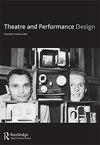Ecoscenography
Q2 Arts and Humanities
引用次数: 3
Abstract
This special double issue of Theatre and Performance Design – dedicated to Ecoscenography – comes at a pivotal moment in time. As I write this today, world leaders are gathering for the 26th UN Climate Change Conference (COP26) in Glasgow, a meeting that is widely accepted as the world’s last chance to avoid catastrophic climate change. Leaders from across the globe are being asked to fundamentally change their ways of doing things. To commit to jettisoning older, outmoded technologies that damage our environment, and embrace new approaches. In turn, they are being asked to focus on the possibilities these new approaches bring with them, to see them not as a risk, an inconvenience or a constraint, but as an opportunity. This special double issue of Theatre and Performance Design is a microcosm of this broader global necessity. The edition invites theatre and performance makers to interrogate and critique the practices of the past and explore the opportunities that arise from this ecological turn. Ecoscenography includes theories and practices which bring an increased awareness of broader ecologies and global issues to performance design. In our call for papers, the editors and I asked for a diverse range of articles that explored emerging practices and philosophies related to ecoscenography. This included an interest in how theatre makers are rethinking their processes and aesthetics for an ecological paradigm: one that promoted environmentally and socially conscious ways of making. The issue asked, ‘How is ecological thinking evoking new materials and processes for theatrical design?’; ‘How are practitioners and scholars critiquing and enhancing the social and environmental advocacy of our field?’; and ‘What new aesthetics are being revealed?’. While architecture, product design and fashion have long demonstrated how a sustainable ethic can lead to new practices and aesthetics, we are yet to fully grasp what a socially and environmentally conscious approach entails for the performing arts. The articles in this special double issue reveal the diversity of ecological practice in scenography across the globe, from North America to Australia, Europe and India. They feature innovations across disciplines of set, costume, lighting and sound design, both within and beyond traditional theatre contexts. In addition to the inevitability of energy and waste reduction, the authors demonstrate what an ecological approach to scenography does – how it influences ways of thinking and working to seize the potential that this new era of environmental uncertainty demands. While many of the authors readily admit to the challenges of pursuing a sustainable path, they also hint at what the future holds for scenography that embraces more ecologically, socially and politically engaged ways of doing things. What was once a niche interest of a handful of designers worldwide is now becoming a burgeoning subject across academia and practice. This transition has been eagerly awaited and I am honoured to be able to highlight the work of those at the vanguard of this movement. The double issue opens with ‘In Words and Chairs: Making Meaning of Sustainability, Equity and Circularity in American Theatrical Design and Production’ by Sandra Goldmark and这个特别的双刊戏剧和表演设计-致力于生态景观-在时间的关键时刻到来。就在我今天写这篇文章的时候,世界各国领导人正在格拉斯哥参加第26届联合国气候变化大会(COP26),这次会议被普遍认为是世界避免灾难性气候变化的最后机会。世界各地的领导人都被要求从根本上改变他们做事的方式。致力于抛弃破坏我们环境的旧的、过时的技术,采用新的方法。反过来,他们被要求把重点放在这些新方法带来的可能性上,不要把它们视为风险、不便或限制,而是一种机会。本期《戏剧与表演设计》特刊是这种全球需求的一个缩影。该版本邀请戏剧和表演制作人对过去的实践进行质疑和批评,并探索从这种生态转向中产生的机会。生态景观学包括理论和实践,将更广泛的生态和全球问题的意识提高到表演设计中。在我们的论文征集中,我和编辑们要求发表各种各样的文章,探讨与生态景观学相关的新兴实践和哲学。这包括对戏剧制作者如何重新思考他们的过程和美学的生态范式的兴趣:一种促进环境和社会意识的制作方式。问题是:“生态思维如何为戏剧设计激发新的材料和工艺?”“从业者和学者如何批评和加强我们领域的社会和环境倡导?”“有什么新的美学被揭示出来?”虽然建筑、产品设计和时尚早已证明了可持续的道德准则如何带来新的实践和美学,但我们还没有完全掌握表演艺术需要的社会和环境意识。本期特刊的文章揭示了从北美到澳大利亚、欧洲和印度,全球范围内生态实践的多样性。它们的特点是在布景、服装、灯光和声音设计等学科上的创新,既包括在传统戏剧环境内,也包括在传统戏剧环境之外。除了减少能源和废物的必然性之外,作者还展示了生态方法对场景的作用-它如何影响思维方式和工作方式,以抓住这个环境不确定性新时代所要求的潜力。虽然许多作者欣然承认追求可持续发展道路的挑战,但他们也暗示了未来场景设计的前景,包括更多的生态,社会和政治参与的做事方式。曾经是全球少数设计师的小众兴趣,现在已经成为学术界和实践中的新兴学科。人们热切地期待着这一过渡,我很荣幸能够强调这一运动的先锋所做的工作。这期双刊以《言语与椅子:在美国戏剧设计和制作中创造可持续性、公平性和循环性的意义》开篇,作者是桑德拉·戈德马克和
本文章由计算机程序翻译,如有差异,请以英文原文为准。
求助全文
约1分钟内获得全文
求助全文
来源期刊

Theatre and Performance Design
Arts and Humanities-Visual Arts and Performing Arts
CiteScore
0.40
自引率
0.00%
发文量
14
 求助内容:
求助内容: 应助结果提醒方式:
应助结果提醒方式:


